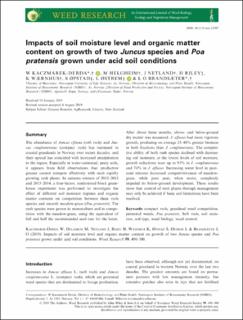| dc.contributor.author | Kaczmarek-Derda, Wiktoria Anna | |
| dc.contributor.author | Helgheim, Marit | |
| dc.contributor.author | Netland, Jan | |
| dc.contributor.author | Riley, Hugh | |
| dc.contributor.author | Wærnhus, Kjell | |
| dc.contributor.author | Øpstad, Samson | |
| dc.contributor.author | Østrem, Liv | |
| dc.contributor.author | Brandsæter, Lars Olav | |
| dc.date.accessioned | 2020-12-01T11:16:32Z | |
| dc.date.available | 2020-12-01T11:16:32Z | |
| dc.date.created | 2019-10-29T10:19:09Z | |
| dc.date.issued | 2019 | |
| dc.identifier.citation | Weed research (Print). 2019, 59 (6), 490-500. | en_US |
| dc.identifier.issn | 0043-1737 | |
| dc.identifier.uri | https://hdl.handle.net/11250/2711139 | |
| dc.description.abstract | The abundance of Juncus effusus (soft rush) and Juncus conglomeratus (compact rush) has increased in coastal grasslands in Norway over recent decades, and their spread has coincided with increased precipitation in the region. Especially in water‐saturated, peaty soils, it appears from field observations that productive grasses cannot compete effectively with such rapidly growing rush plants. In autumn–winters of 2012–2013 and 2013–2014, a four‐factor, randomised block greenhouse experiment was performed to investigate the effect of different soil moisture regimes and organic matter contents on competition between these rush species and smooth meadow‐grass (Poa pratensis). The rush species were grown in monoculture and in competition with the meadow‐grass, using the equivalent of full and half the recommended seed rate for the latter. After about three months, above‐ and below‐ground dry matter was measured. J. effusus had more vigorous growth, producing on average 23–40% greater biomass in both fractions than J. conglomeratus. The competitive ability of both rush species declined with decreasing soil moisture; at the lowest levels of soil moisture, growth reductions were up to 93% in J. conglomeratus and 74% in J. effusus. Increasing water level in peat–sand mixture decreased competivitiveness of meadow‐grass, while pure peat, when moist, completely impeded its below‐ground development. These results show that control of rush plants through management may only be achieved if basic soil limitations have been resolved. | en_US |
| dc.language.iso | eng | en_US |
| dc.rights | Attribution-NonCommercial-NoDerivatives 4.0 Internasjonal | * |
| dc.rights.uri | http://creativecommons.org/licenses/by-nc-nd/4.0/deed.no | * |
| dc.title | Impacts of soil moisture level and organic matter content on growth of two Juncus species and Poa pratensis grown under acid soil conditions | en_US |
| dc.type | Peer reviewed | en_US |
| dc.type | Journal article | en_US |
| dc.description.version | publishedVersion | en_US |
| dc.source.pagenumber | 490-500 | en_US |
| dc.source.volume | 59 | en_US |
| dc.source.journal | Weed research | en_US |
| dc.source.issue | 6 | en_US |
| dc.identifier.doi | 10.1111/wre.12387 | |
| dc.identifier.cristin | 1741554 | |
| dc.relation.project | Norges forskningsråd: 190492 | en_US |
| cristin.unitcode | 192,10,2,0 | |
| cristin.unitname | Institutt for plantevitenskap | |
| cristin.ispublished | true | |
| cristin.fulltext | original | |
| cristin.qualitycode | 1 | |

